The Rosen Outdoor Sculpture Competition & Exhibition is a national juried competition presented annually by the Turchin Center for the Visual Arts on the campus of Appalachian State University in Boone, North Carolina. The Rosen has become an integral part of An Appalachian Summer Festival, the university’s annual multi-arts celebration presented by the Office of Arts & Cultural Programs.
Martin and Doris Rosen established the Rosen Outdoor Sculpture Competition & Exhibition in 1987. For the past 28 years, this nationally recognized competition has served as a highlight and point of pride for Appalachian State University’s summer arts festival, An Appalachian Summer Festival, and has brought a remarkable array of contemporary sculpture to Boone, North Carolina.
To mark the 29th season of this important program in the summer of 2015, the Rosen Sculptural Invitational will feature work curated by the Turchin Center’s curatorial staff in honor of Martin and Doris Rosen. A selection of artists who have participated in past Rosen exhibitions will be invited to submit new work for display on the Appalachian campus. The invitational format allows the Turchin Center to work with artists whose sculpture was especially significant and meaningful to the Rosen Family.
On the occasion of the Rosen’s 50th wedding anniversary in October 1999, their children established the Martin and Doris Rosen Scholarship to assist rising junior or senior art majors at Appalachian State. The continued support and generosity of the Rosen Family has also made possible the 29th Rosen Sculpture Invitational, which promises a fascinating exploration into the world of contemporary sculpture!
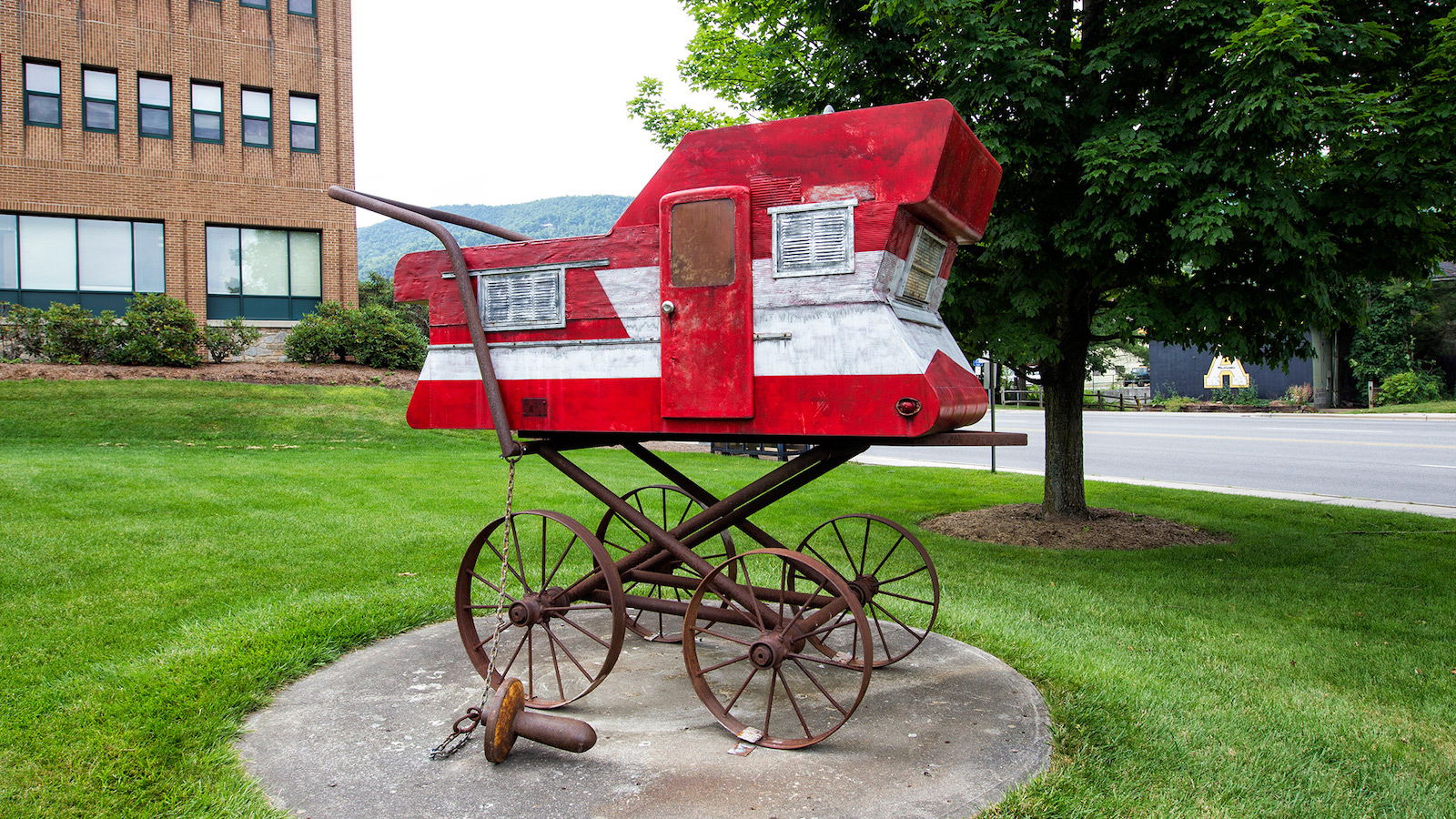
Robbie Barber, Southern Comfort
Sculptures
Composition #5
Dana Gingras
Mooresville, NC
Granite, marble, steel
6′ x 2′-1″ x 1′
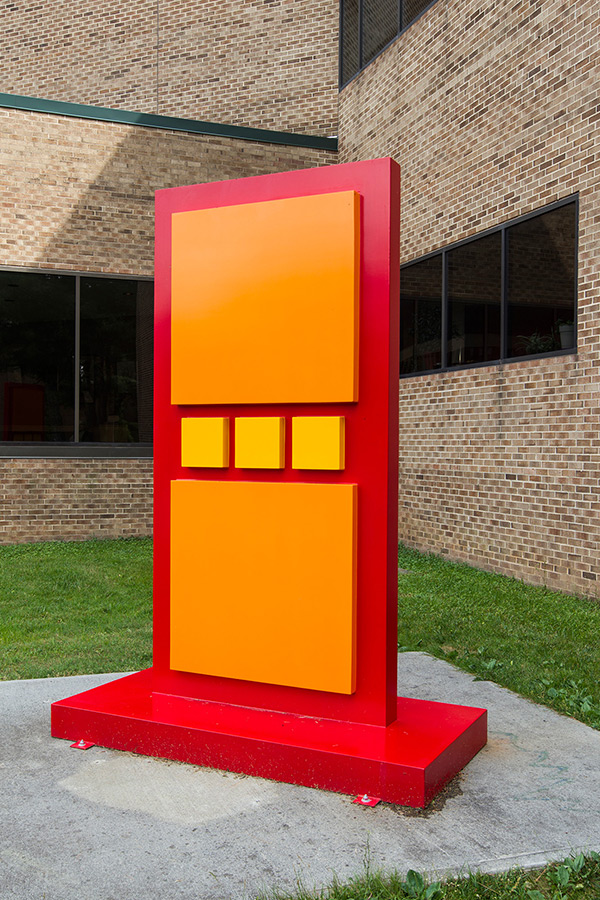
Artist statement
I have always had a fascination with color. However, it has been absent in my work for a number of years as I focused on more natural patinas and finishes. Recently I found an old copy of Josef Albers book Interaction of Color and my love for color was born anew. I decided to create a body of work that would balance playfulness, and a more serious exploration of color theory.
Composition #5 is the 2nd piece in the series “contemplating color”. It celebrates basic forms, and explores the juxtaposition of colors and their interactions with the changing light and shadows.
At first glance Composition #5 is meant to simply delight. Its bright primary colors and basic forms are easily related to, and are meant to evoke memories of a simple carefree time. However, upon closer inspection one will notice that the colors are not static. Each color reacts differently to the one next to it depending on time of day and the changing seasons. Composition #5 is a piece that is in a state of constant flux. It is a fun way to encourage viewers to slow down and contemplate the subtle nature of color.
About the artist
Dana Gingras grew up surrounded by nature in rural Northwest Connecticut, the foothills of the Berkshire Mountains. After traveling extensively throughout Europe and the United States he received his degree from The University of Connecticut. Continuing his education he won a coveted apprenticeship at Lorenz Studios and spent the next three years refining his skills working with noted glass and steel sculptor Larry Livolsi. For the past fifteen years he has maintained a studio focusing on large-scale sculpture and custom interior pieces. Currently based in Mooresville NC. His work can be found in public and private collections across the country.
His primary mediums are glass, steel, and wood. Dana’s work comes from the process of understanding these materials, their intrinsic properties, and inherent beauty. “My goal is to create something new and visually stimulating, yet still retain the natural dignity of material”. He currently runs Gingras Studios in Mooresville, NC.
For more information, visit www.danagingras.com.
Tier 2000
Ann Melanie
Greenville, NC
Welded steel
20′ x 7’6″ x 7’6″
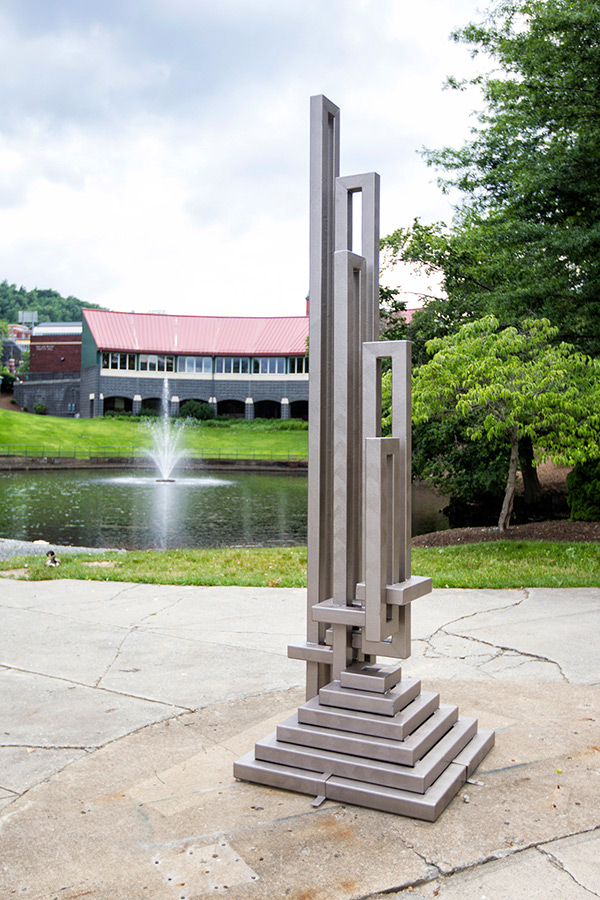
Artist statement
My work represents my explorations in methods, materials, and scale. The work is structural in nature drawing from constructivism, minimalism, and my affinity for straight lines and right angles; it encompasses a wide variety of media and process, ranging in scale from miniature to monumental I choose simple geometric shape as the basis of my work, this allows me great latitude in the creation of my sculpture. These simple forms lend themselves readily to casting, carving, fabrication, and construction; it also allows me unlimited opportunity to explore surface. The use of simple shape establishes a level of recognition for the viewer. The repetition of same or similar elements strengthens the viewers’ sense of the familiar. The rectilinear forms represent windows and doors; windows, which look from my world into yours but keep us apart, and doors, which allow us, passage through. Windows and doors are not literal images, but act as a symbolic reference to ideas, images, and emotions. My work is the sum of my life experiences it has no specific meaning and it means everything. The work is simple in its form and complex in its construction.
Fern Temple IV
FR Austin Collins
Notre Dame, IN
Steel
27′ x 6′ x 6′
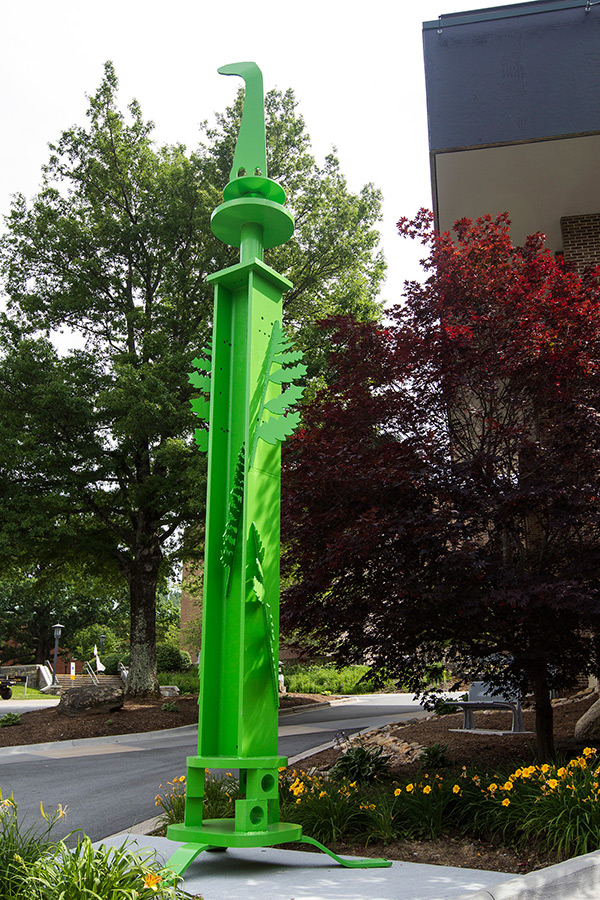
Artist statement
For the past 15 years I have been working on a series of sculptures entitled The Temple Series. This series of nearly 30 works is constructed of individual pieces of mild steel, which range in height from 5 to 25 feet.
The Temple Series continuity is the product, largely, of a trip I made to Haiti some years ago. While in Haiti I encountered numerous works of art, which expressed the deep spiritual, cultural and political struggles Haitians have undergone over the course of the twentieth century. But these works also revealed how art can transcend the everyday, can lift one above the rawness or brutality of social strife, and can offer a space governed by a calmness that can, in turn, allow for the kind of reflection that leads to social awareness and social change. In other words, what became clear in the Haitian works I observed was how sculpture can lift one out of the immediacy of his or her context not as pure escapism, but for spiritual, social and political affect. One was lifted out and offered the contemplative room to see and imagine how things could be different. The culmination of this kind of viewing encounter was, for me, to step back into a world as a committed agent of change.
My hope in the Temple Series work is to capture this same process of produced reflection, which can invoke in the viewer a sense of sacred space, of retreating, of reflection, and of the need to take active charge of his or her destiny. The “Temple Series” celebrates the convolutions of the individual by first isolating the self as unique, and then by reintroducing that self into a community of similar and dissimilar selves which, taken together, form a more whole or complete landscape that ultimately gives the self meaning. This back and forth is what I mean when I speak above about my attraction to sculpture’s dynamism, of its ability to shake us up and calm us down, and of its egalitarian essence.
About the artist
Professor Austin Collins is a sculptor known for his large-scale metal work that draws on and extends the Modernist tradition. His work has been featured in 137 exhibitions and is included in over 57 public and private collections. He has also given 35 public lectures on his work at various institutions across the country.
Collins’s area of practice includes public art, large outdoor sculpture, installation art and liturgical art. The theme of his creative work often deals with political and social issues.
Collins has exhibitions at Northwestern University, University of Tennessee, University of Alabama, University of California and the University Virginia. He currently has work on view at: University of Alabama, City of Huntsville, AL Sacred Heart University Fairfield, CT, University of Toledo, Toledo, OH, Indiana University, South Bend, IN, City of Port Huron, MI, East Carolina University, Greenville, NC. Fernwood Botanical Garden & Nature Preserve, Niles, MI, Fredrik Meijer Gardens & Sculpture Park, Grand Rapids, MI and Bowling Green State University, Bowling Green, OH. His work has been reviewed and written about in publications such as Sculpture Magazine, The Chicago Sun-Times, New City Chicago, The Detroit News, The Indianapolis Star and Dialogue.
Collins Studied art at the University of California at Berkeley and received a M.F.A. in sculpture from Claremont Graduate University. Collins is currently a professor of sculpture at the University of Notre Dame, a position he has held for the past 29 years.
For more information, visit www3.nd.edu/~acollins.
Aspiration
Anne Melanie
Greenville, NC
Welded steel
20′ x 12′ x 10′
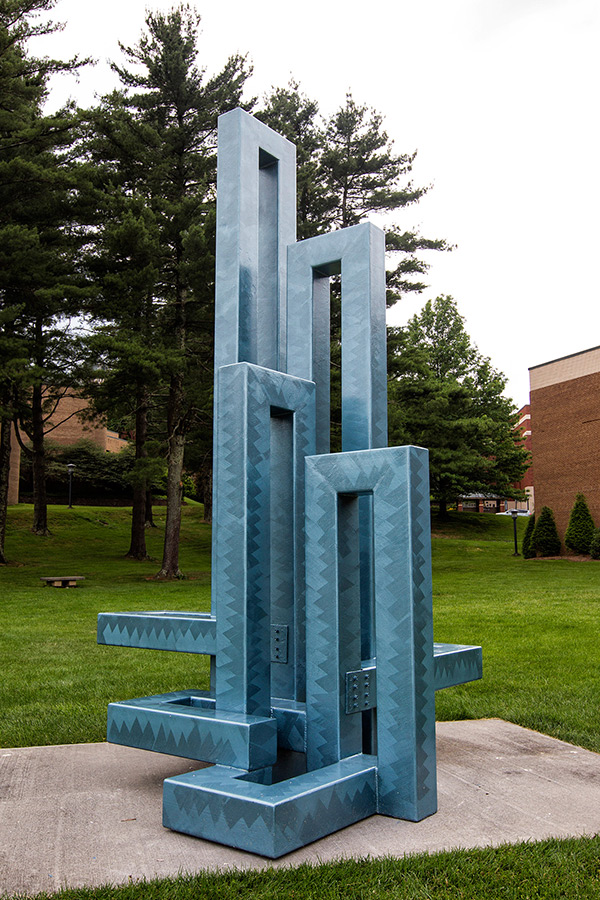
Artist statement
My work represents my explorations in methods, materials, and scale. The work is structural in nature drawing from constructivism, minimalism, and my affinity for straight lines and right angles; it encompasses a wide variety of media and process, ranging in scale from miniature to monumental I choose simple geometric shape as the basis of my work, this allows me great latitude in the creation of my sculpture. These simple forms lend themselves readily to casting, carving, fabrication, and construction; it also allows me unlimited opportunity to explore surface. The use of simple shape establishes a level of recognition for the viewer. The repetition of same or similar elements strengthens the viewers’ sense of the familiar. The rectilinear forms represent windows and doors; windows, which look from my world into yours but keep us apart, and doors, which allow us, passage through. Windows and doors are not literal images, but act as a symbolic reference to ideas, images, and emotions. My work is the sum of my life experiences it has no specific meaning and it means everything. The work is simple in its form and complex in its construction.
About the artist
Ann Melanie, was born in Moses Lake Washington, her family is from Skowhegan Maine; Melanie received her MFA in sculpture in 1995 from East Carolina University. Her work includes gallery-scale and large public sculptures. Melanie uses simple forms that lend themselves to casting, carving and fabrication. She has shown throughout the United States in many venues, including the Rosen Outdoor Sculpture Competition, and The Pyramid Sculpture Park in Hamilton, Ohio. Her work is part of the permanent collection of the East Carolina Sculpture Park. She currently lives in Greenville, North Carolina where she is the academic advisor for the School of Art and Design at East Carolina University.
Infrastructure 1 & 2
Arny Nadler
St Louis, MO
Concrete and steel
#1: 5’3″ x 1’5″ x 1’4″
#2: 5′ x 1’11” x 1’8″
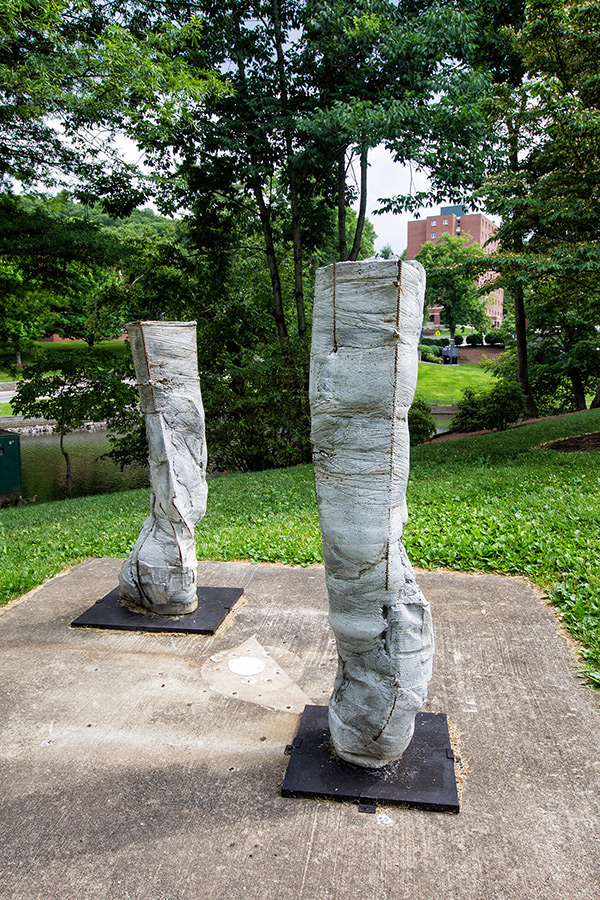
Artist statement
At the heart of my activity as a sculptor is a fascination with form. Feats of engineering, both utilitarian and evolutionary, have always appealed to me. I am fascinated watching a cantilever bridge slowly rise, pause, and lower gently back down over the river in my home town of Chicago. I am equally awed by the intricacy of organic structures—a wasp’s nest, a brain coral, the exoskeleton of a crustacean. The efficiency, purposefulness and specificity of design of both the built and organic environment converge in my new work. This confluence of influences has lead to forms with a multitude of associations. In my Infrastructure series, I used cardboard and plastic sheeting to create flexible molds for casting concrete. By casting one layer on top of the next, each of the dozen or so layers responds to the one immediately preceding it, resulting in column-like forms that reference architecture and the figure.
About the artist
Arny Nadler is an associate professor of art at the Sam Fox School of Design and Visual Arts at Washington University in St. Louis, where he serves as the chair of the undergraduate art program. He has exhibited and lectured at universities, art centers and other venues across the country, including the Evanston Art Center, the Turchin Art Center, Sculpture Key West, the Kingston Sculpture Biennial, Maryland Hall Center for the Creative Arts, Western Michigan University, the Catherine Konner Sculpture Park at Rockland Center for the Arts, Cedarhurst Center for the Arts and the Newport Beach-California Civic Center. Whelm, a site-specific sculpture commissioned by Gallery 210 on the campus of the University of Missouri- St. Louis was built entirely on site using 11,000 feet of steel rebar. Nadler’s work has been reviewed in several publications including Art in America and he was one of ten artists granted a $20,000 fellowship from the Regional Arts Commission of St. Louis in 2013. Additionally, he is a recipient of a George Sugarman Foundation Grant as well as two Sam Fox School Faculty Creative Research Grants from Washington University. He received his MFA in sculpture from Cranbrook Academy of Art in Bloomfield Hills, MI and his BFA in sculpture from Washington University in St. Louis.
For more information, visit arnynadler.com.
Southern Comfort
Robbie Barber
Waco, TX
Welded steel, paint
9′ x 9′ x 5′
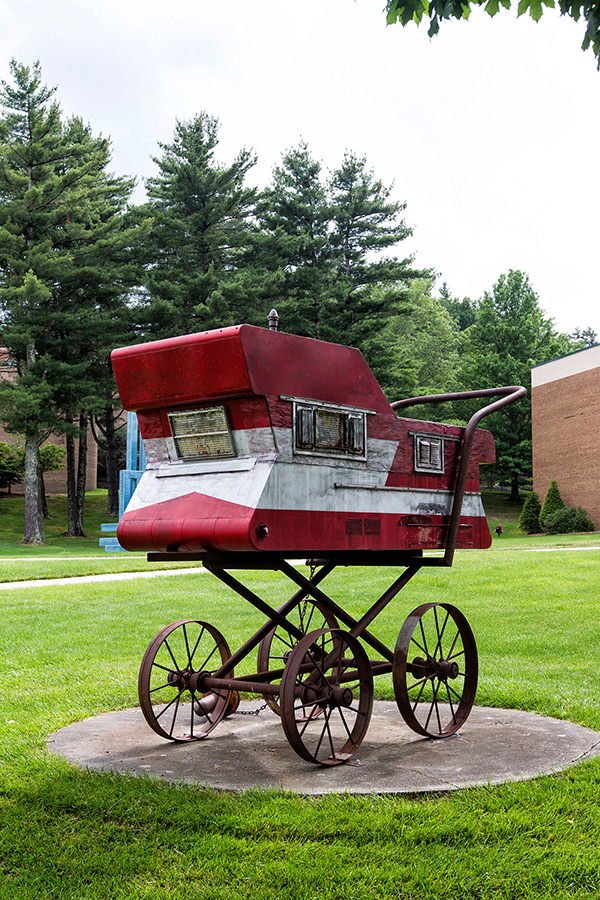
Artist statement
My travels throughout rural America have attracted me to the strong visual character of this country’s vernacular architecture. Vintage lapboard houses, mobile homes, and agriculture-related structures have become regional icons that ultimately tell the stories of their inhabitants and builders. This implied history interests me deeply. Typically considered eyesores, these structures are glaring reminders of the social and economic plight of much of our society. Yet on a formal level, they have a hidden beauty, complex in color, texture, and shape. Much like America’s Ashcan School, I am interested in the depiction of unheralded everyday subject matter and the subtle nobility in these castles of the mundane.
Southern Comfort represents a mobile home transformed into a giant baby carriage, which lends new meaning to the phrase “baby boomer”. An homage to the homemade assemblages that dot the American roadside (dinosaurs, muffler men, cars on poles), Southern Comfort elevates the mobile home to the level of an American icon, right beside monster trucks and professional wrestling.
About the artist
Robbie Barber is currently Associate Professor of Art at Baylor University in Waco, Texas. Born in Williamston, North Carolina in 1964, he was raised on a farm near the Roanoke River in Martin County. He received his BFA degree from East Carolina University in 1987 and his MFA degree from the University of Arizona in 1991. He has gained notoriety as a sculptor working in a variety of media, and is the recipient of numerous awards. These include a North Carolina Arts Council Fellowship and a Southern Arts Federation/NEA Fellowship in Sculpture. He has exhibited at the Grace Museum in Abilene, Texas, Socrates Sculpture Park in Long Island City, New York, the Roswell Museum and Art Center in Roswell, New Mexico, the Rocky Mount Art Center in Rocky Mount, North Carolina, and Grounds For Sculpture in Hamilton, New Jersey, to name a few.
For more information, visit robbiebarber.com.
A Dress for Ana Mendieta
Jennifer Hecker
Brockport, NY
Cast Bronze
2’4″ x 1’6″ x 1’3″
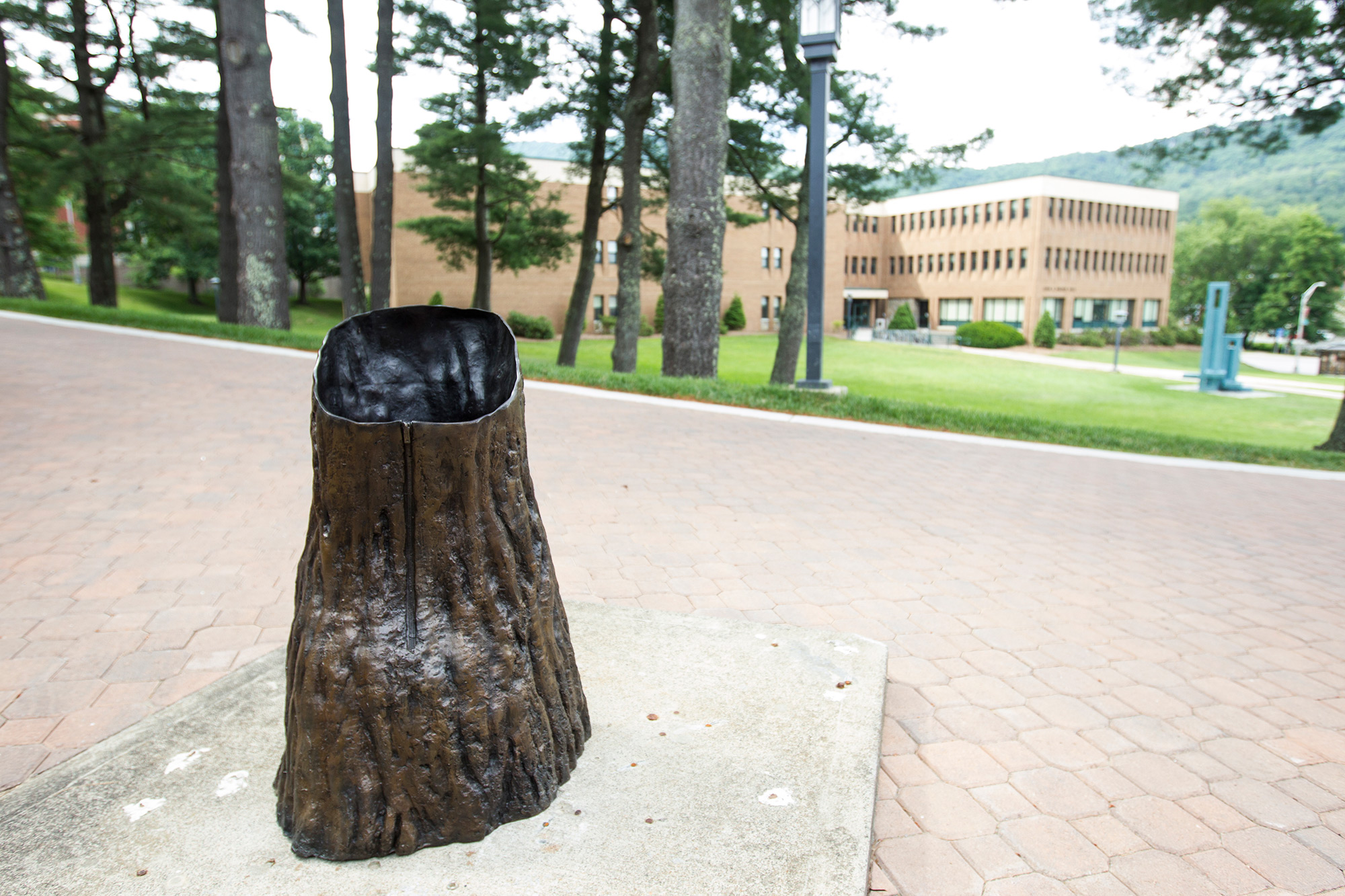
Artist statement
I’m interested in layers—physical layers and layers of meaning. My work always starts with a recognizable form—a drain, a dress, a shelf, a bed, a heart. It is that recognizable form that is the entryway into the work, and where that entrance leads is where the art lies. It is a place discovered through making analogies between forms and ideas, through using physical matter to realize spiritual concepts, and through allowing metaphors to bring meaning into the realm of the mundane. I work with a variety of materials and techniques because they are the means through which I communicate, and so, more materials and methods mean a larger vocabulary with which to speak.
This work was inspired by a photograph from Ana Mendieta’s “Tree of Life” series (1977) in which she covered her own body with mud, grass and leaves, and stood against tree trunks, accentuating the connectedness between nature and women. This is a bark dress—strapless and short, with a side slit and a zipper down the back—cast from a mold I took off a tree trunk.
(Ana Mendieta died in 1985 at the age of 36 from a fall from her 34th floor bedroom window. Her husband, the sculptor Carl Andre, was tried and acquitted of her murder, claiming is was a suicide.)
About the artist
Jennifer Hecker has an extensive and diverse exhibition record that includes solo shows, commissions, collaborative installations, public art projects, outdoor sculpture shows, adjudicated exhibitions, and permanent collections. Recent exhibitions include: “The Next: A Studio Glass Movement Continuum” at Tower Fine Arts Gallery in Brockport, NY (2015); “Taos Art Glass Invitational” at David Anthony Fine Art in Taos, NM (2014); 4th Biennial Western Cast Iron Art Exhibition at University of Wyoming in Laramie (2014); and “Water: A Universal Human Right,” at the State Street Gallery in Chicago, organized by the Chicago Women’s Caucus for Art (2014). In 2013, Jennifer was one of 42 regional artists invited to create a new work inspired by an artwork in the permanent collection of the Memorial Art Gallery in Rochester, NY in celebration of its centennial. In 2011, Jennifer was one of 30 artists from around the world to be featured in the book Sculpture and Design With Recycled Glass by Cindy Ann Coldiron (Schiffer Publishing). Jennifer’s sculptures were twice selected for inclusion in the prestigious Rosen National Outdoor Sculpture Exhibition at Appalachian State University in Boone, North Carolina (1996 & 2011). In 2006, her commissioned outdoor sculpture for the Village of Brockport, Les Racines et les Raisons (The Roots and the Reasons) was dedicated in Remembrance Park. In 2004, she completed a significant commission for a three-part, site-specific sculpture for Christ Church in Pittsford, New York. Her work is included in the permanent collections of The Red Cross in Rochester, NY; The Children’s Inn at the National Institute of Health in Bethesda, MD, and SUNY College at Brockport, as well as private collections in New York, Virginia, Illinois, Florida, and Minnesota.
Jennifer Hecker is a professor in the Department of Art at The College at Brockport, where she has taught all levels of sculpture, as well as general education art courses since 1989. In 1999, she was awarded a Chancellor’s Award for Excellence in Teaching, and in 2002 she completed a 6-year term as department chairperson. Jennifer received her MFA in Sculpture from the University of Minnesota in 1984, and her BFA in Sculpture with honors from the University of Illinois in 1980.
For more information, visit jenniferhecker.net.
Testament
Jennifer Hecker
Brockport, New York
Steel
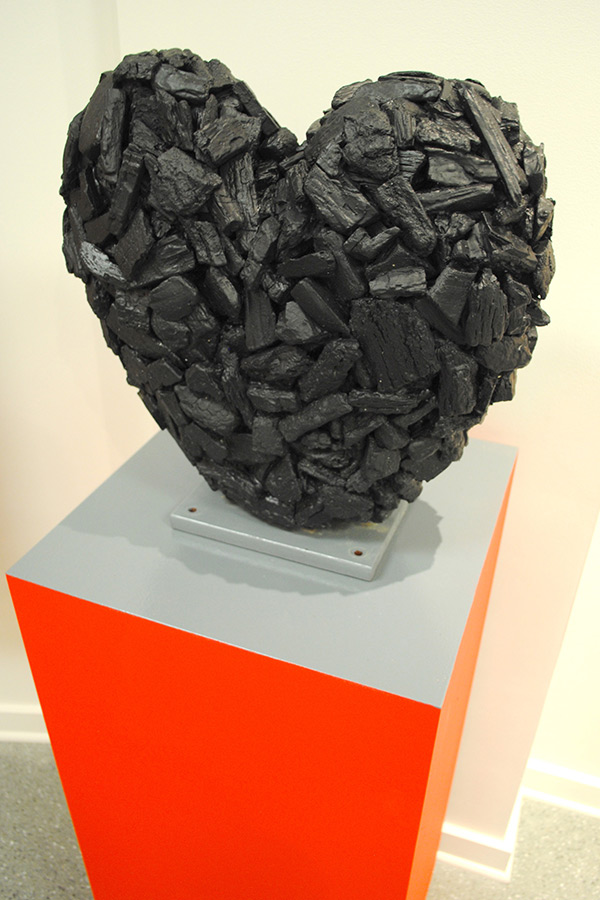
Artist statement
I’m interested in layers—physical layers and layers of meaning. My work always starts with a recognizable form—a drain, a dress, a shelf, a bed, a heart. It is that recognizable form that is the entryway into the work, and where that entrance leads is where the art lies. It is a place discovered through making analogies between forms and ideas, through using physical matter to realize spiritual concepts, and through allowing metaphors to bring meaning into the realm of the mundane. I work with a variety of materials and techniques because they are the means through which I communicate, and so, more materials and methods mean a larger vocabulary with which to speak.
A charcoal heart intended to suggest strength over adversity.
Two Witnesses
Shawn Morin
Bowling Green, OH
Bronze, granite, steel
10′ 3″ x 3’6″ x 1’9″
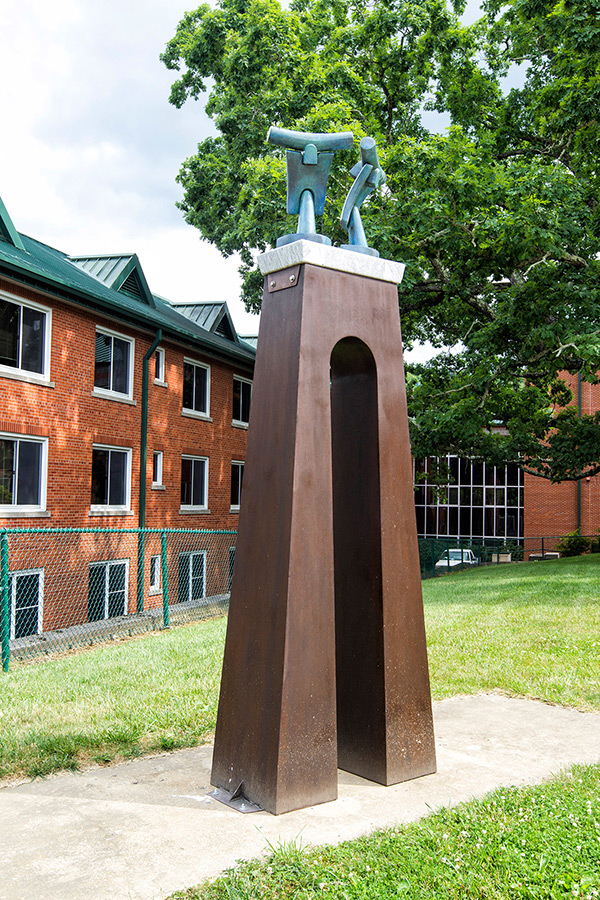
Artist statement
I have long approached the sculptural process through the use of multiple materials. Granite, marble, limestone, steel, stainless steel, bronze, iron, glass and wood can be found in one or more combinations within the majority of my work. The incorporation of colors and textures, as well as a multitude other associated physical, spiritual, and tactile qualities inherent to these materials are also of great importance. However, for me, the overarching truth of my work is that compositional complexity can only be achieved by the constant use of multiple shapes and forms. These shapes and forms by themselves are of no great value or significance to anyone other than the minimalist, which I am not. However, when these simple, benign shapes are put together in similar fashion to the way a child plays with blocks, one can immediately see that there are literally limitless compositional opportunities.
Crevice
Shawn Morin
Bowling Green, OH
Granite, marble, steel
8’6″ x 6′ x 3
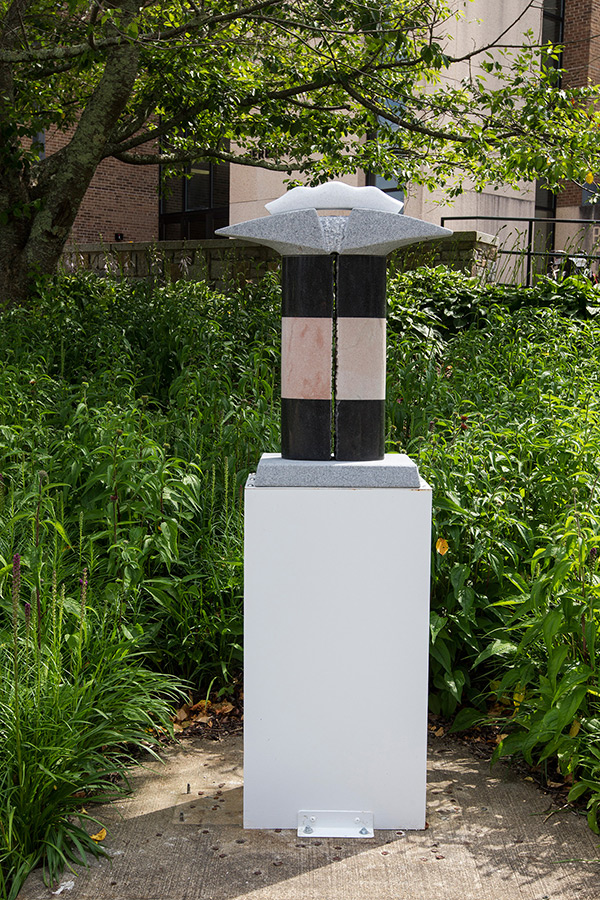
About the artist
Just prior to receiving his B.F.A. in sculpture, Shawn Morin asked one of the professors he admired most: “So, do you think I have what it takes to be an artist”? Without missing a beat or bating an eye, he smiled and said, “NO, you don’t.” A few months later Morin entered the M.F.A. program as the University of Georgia in Athens as an “irregular undergrad,” which, when translated means, “we’ll let you enroll on a trial basis, take your money for a year and see what happens”. After successfully completing his first year in Athens, he was fully accepted into the masters program and granted an assistantship. However, a few weeks later he received a letter from the university stating that his assistantship was being revoked and that he was being asked to leave the university due to low GRE test scores. Nevertheless, Morin completed his M.F.A. the following year and at age 26 began his teaching career. Recently, he chaired a committee that abolished the GRE requirement for M.F.A. applicants at BGSU. The very next year, the number of graduate applications in the School of Art more than doubled.
Morin has just completed his nineteenth year as Head of the Sculpture Program at Bowling Green State University in Ohio. He has participated in more than 140 exhibitions throughout the country, and his work can be seen in 15 permanent public collections, and is included in over 35 private collections. Since 1992, nearly every one of Morin’s own graduate students are currently teaching in high schools, colleges, and universities around the country.
For more information, visit shawnmorinsculpture.com.
About the curator
Hank Foreman serves as Assistant Vice Chancellor of Arts and Cultural Affairs as well as Director and Chief Curator of the Turchin Center for the Visual Arts for Appalachian State University. He obtained his M.A. in Art Education from Appalachian, having completed undergraduate studies at the University of North Carolina at Charlotte, with a concentration in Painting and Sculpture. His duties include the administrative responsibilities for An Appalachian Summer Festival, the Performing Arts Series, Farthing Auditorium and the Turchin Center for the Visual Arts.
During his tenure at Appalachian State, Foreman has taken part in the organization of numerous exhibitions, including the associated lectures, symposia, and publications. He has worked closely with the university’s Department of Art, and a wide variety of other campus and community groups, to make gallery resources available to all. One of his earliest exhibitions at Appalachian, Views From Ground Level: Art and Ecology in the Late Nineties, brought internationally acclaimed artists, historians, and critics to the campus and received national attention.
Foreman is also an exhibiting studio artist, and participates in regional and national conferences as a presenter and panelist.
